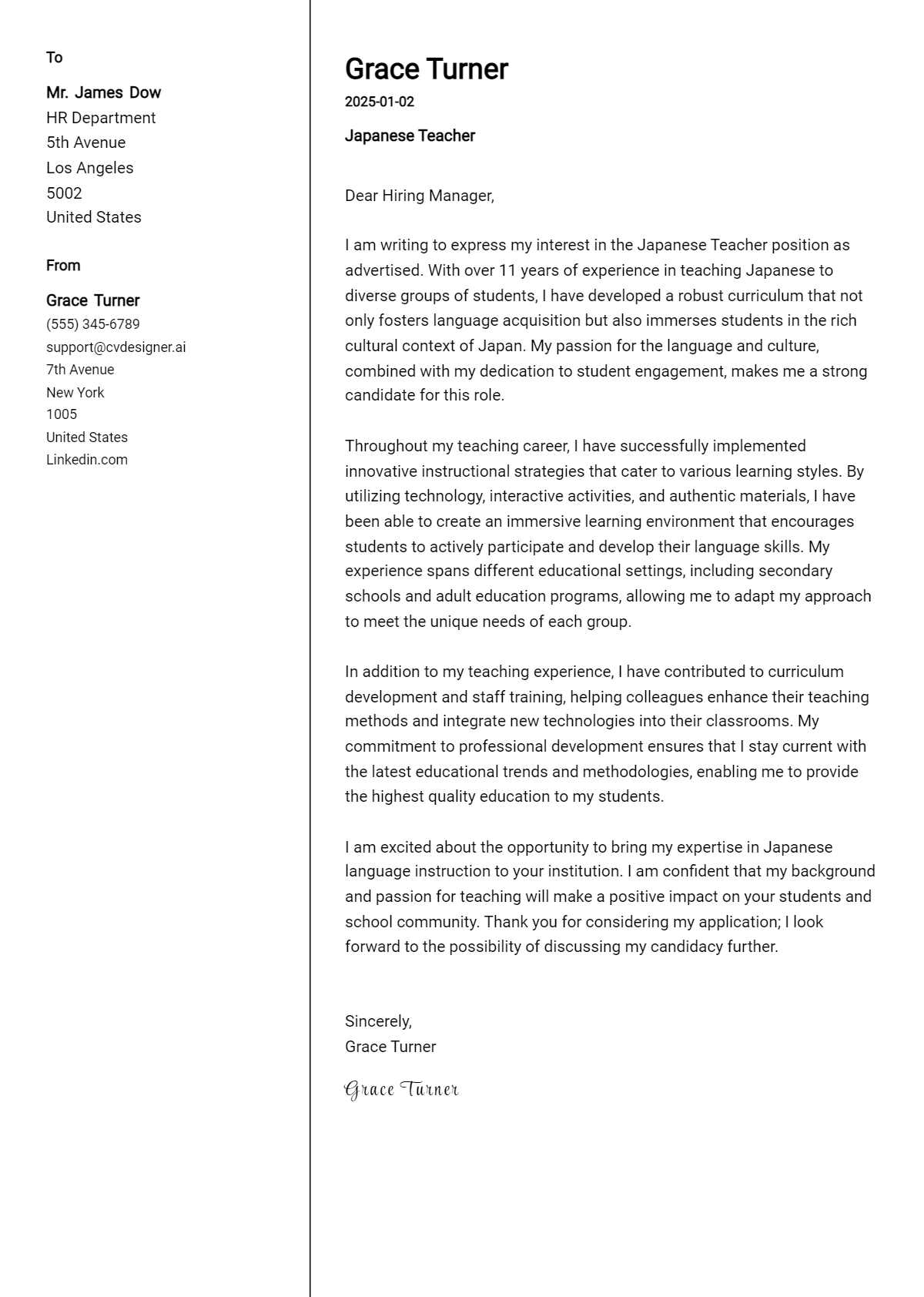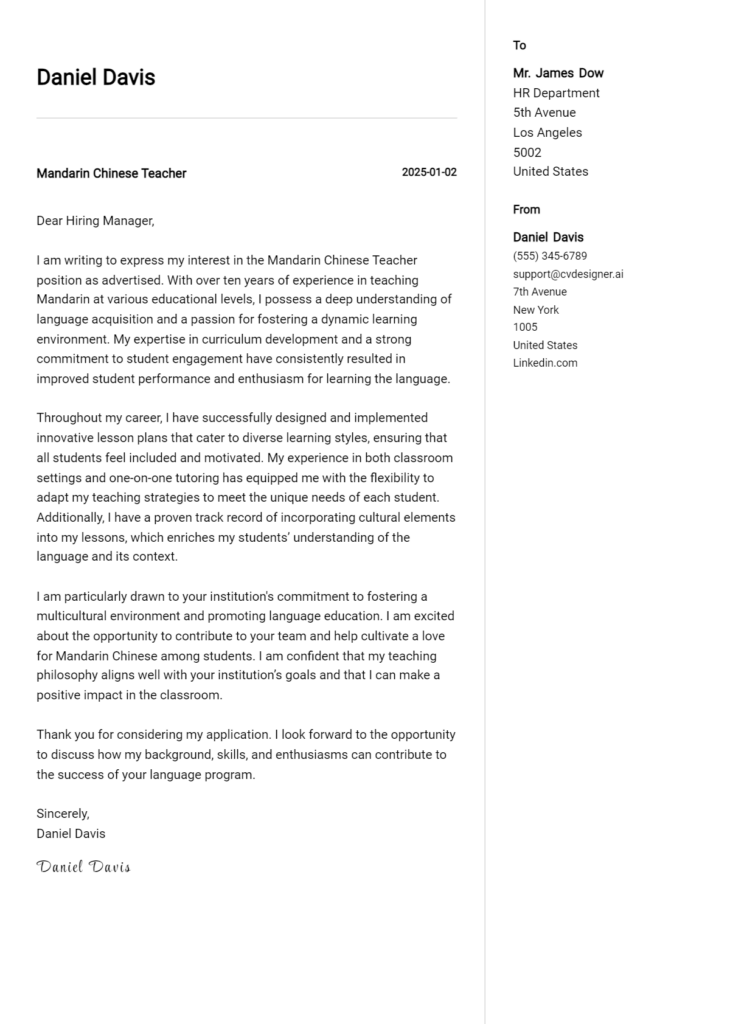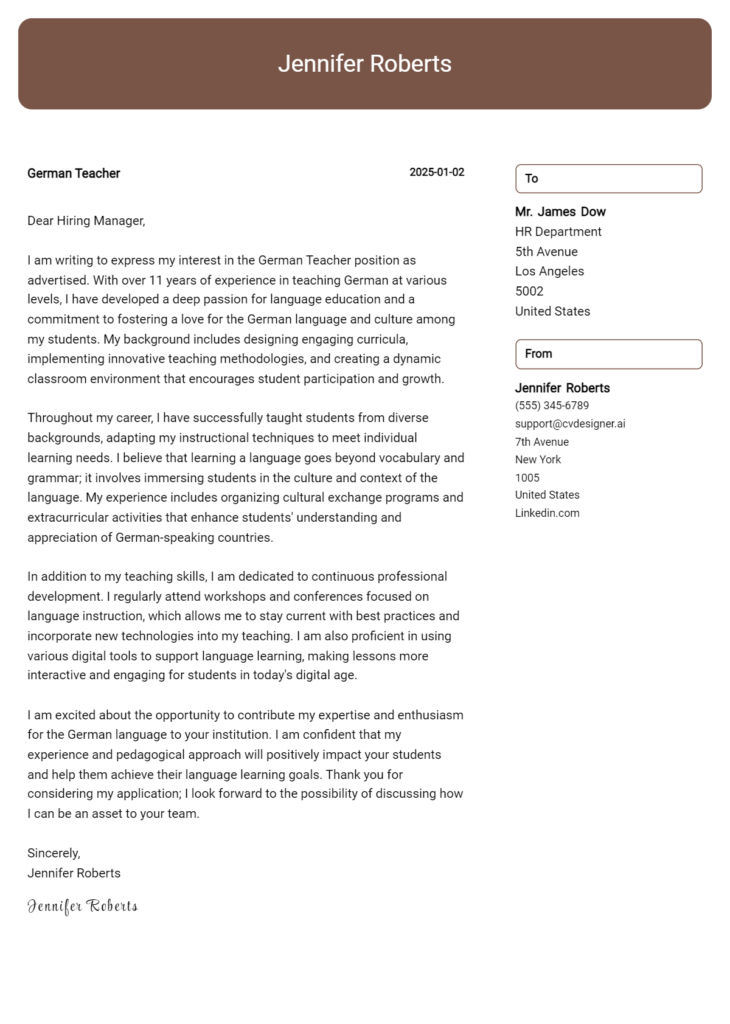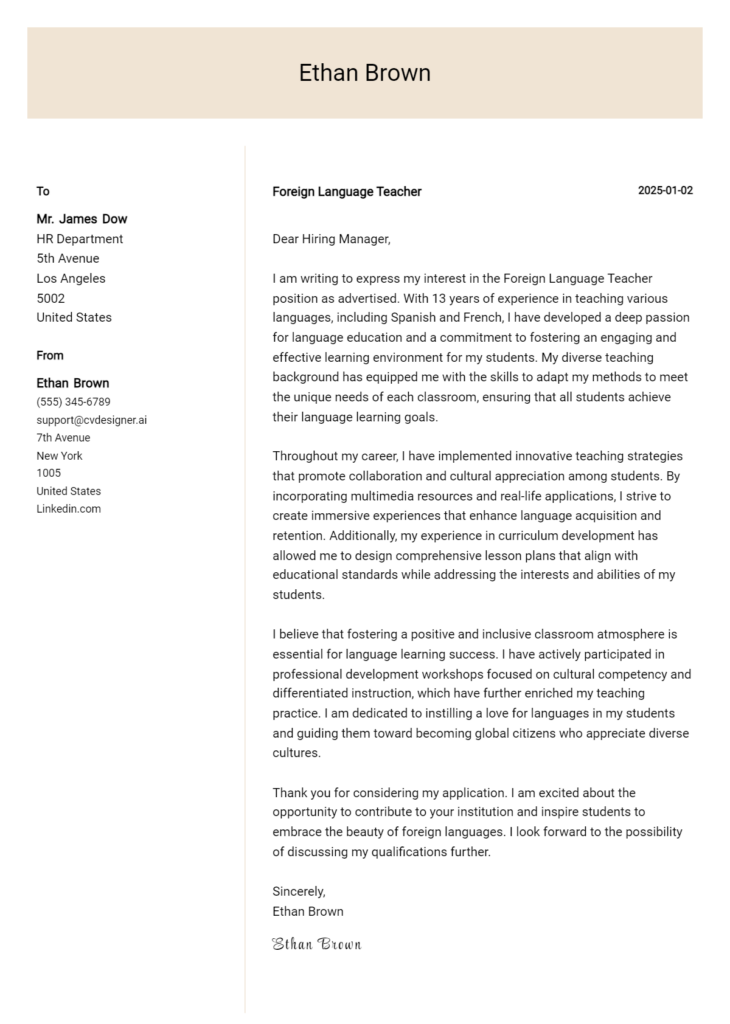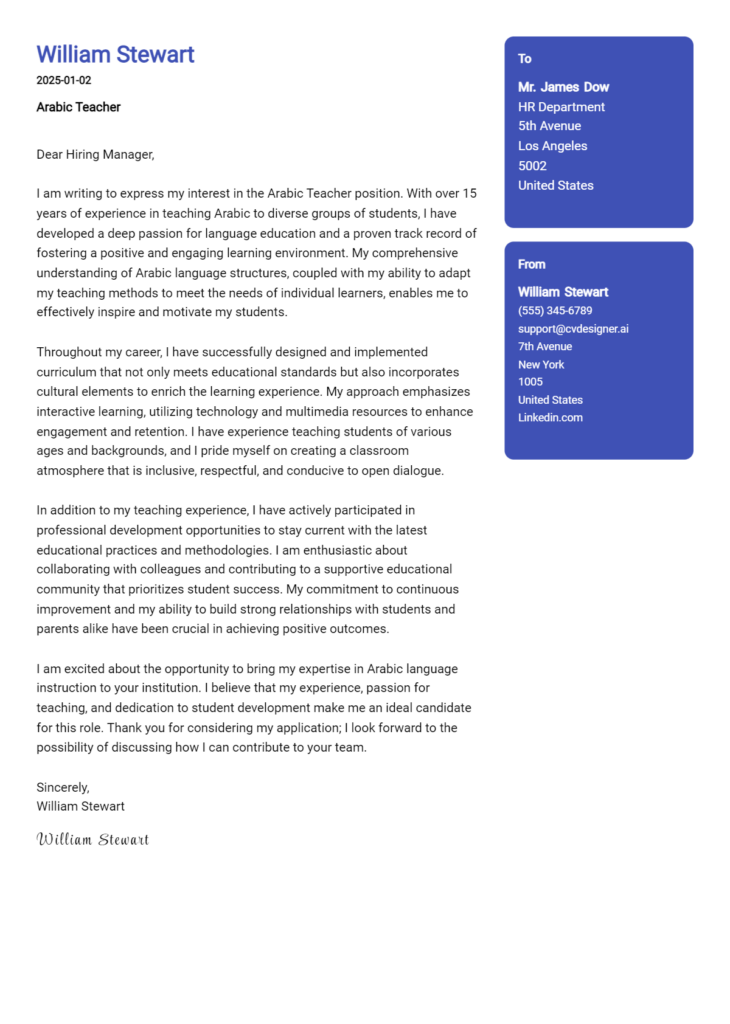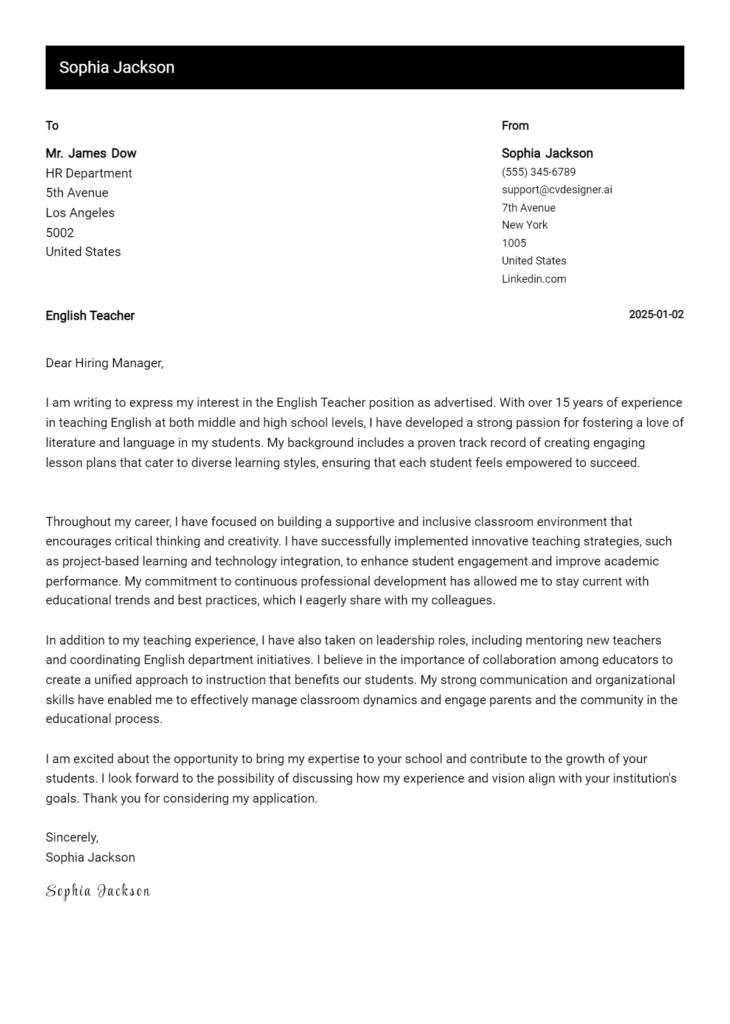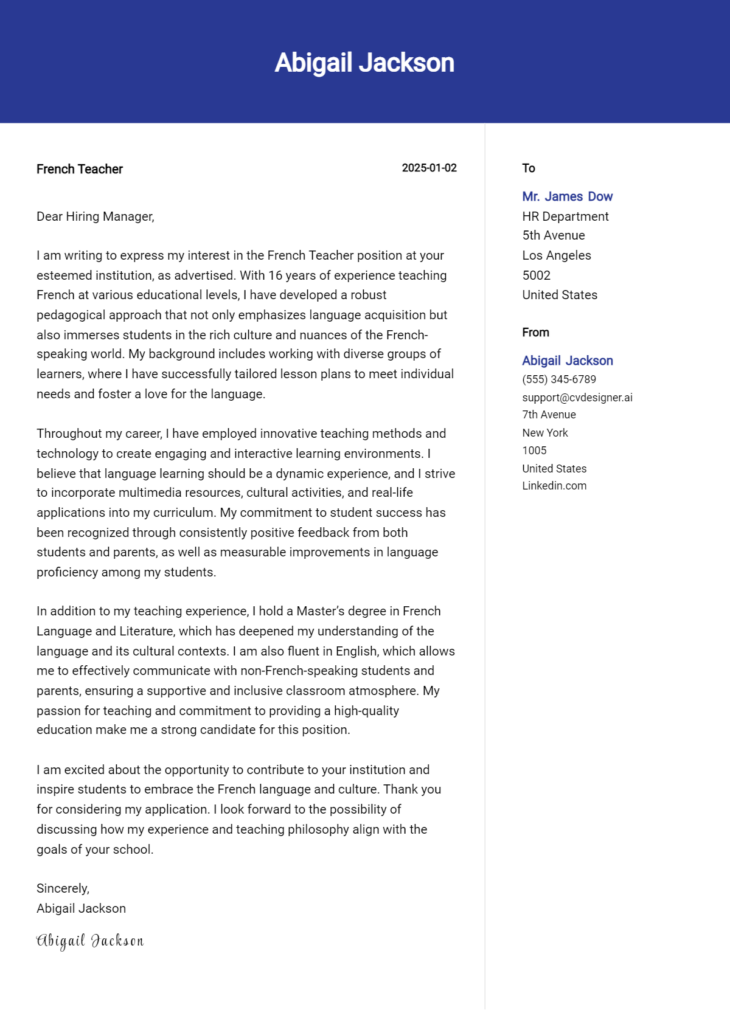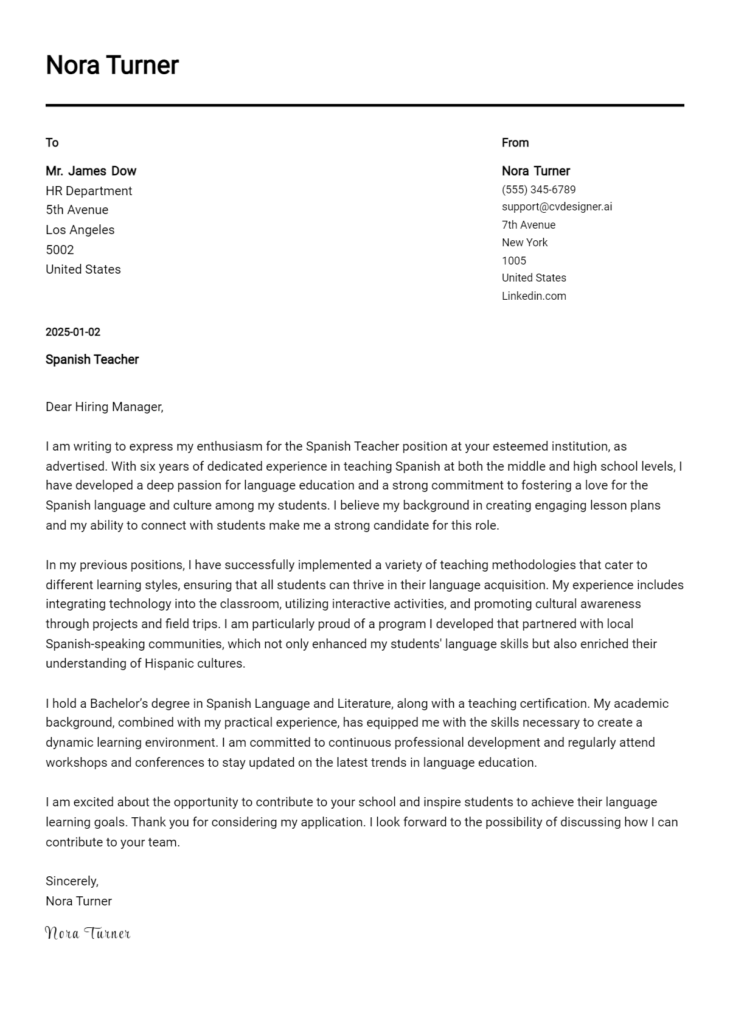Japanese Teacher Cover Letter Examples
Explore additional Japanese Teacher cover letter samples and guides and see what works for your level of experience or role.
How to Format a Japanese Teacher Cover Letter?
Crafting a compelling cover letter is essential for a Japanese Teacher, as it is your first opportunity to make a strong impression on potential employers. The way you format your cover letter not only demonstrates your language proficiency but also reflects your organizational skills and cultural awareness—qualities that are vital in teaching. An effectively structured cover letter can capture the attention of hiring managers, showcasing your teaching philosophy and passion for the Japanese language.
In this guide, we'll outline how to format your cover letter, providing tips and Japanese teaching-specific examples to help create an engaging document.
We'll focus on the essential components of a professional cover letter, including:
- Cover Letter Header
- Cover Letter Greeting
- Cover Letter Introduction
- Cover Letter Body
- Cover Letter Closing
Each section is crucial for emphasizing your qualifications and commitment to education. Let’s dive into each part and explore how to make your Japanese Teacher cover letter shine.
Importance of the Cover Letter Header for a Japanese Teacher
A well-structured cover letter header is crucial for a Japanese Teacher as it establishes the first impression of your application. It should convey professionalism and clarity, ensuring that the recipient can easily identify who you are and how to contact you. The header typically includes your contact information, the date, and the recipient's details such as their name, title, and school or organization. A clear and professional header not only reflects your attention to detail but also sets the tone for the rest of the cover letter.
Strong Example
John Doe 123 Sakura Lane Tokyo, Japan 100-0001 john.doe@email.com (123) 456-7890 October 1, 2023 Ms. Yuki Tanaka Principal Tokyo International School 456 Cherry Blossom Avenue Tokyo, Japan 100-0002
Weak Example
john doe tokyo, japan johndoe@email 10/1/23 yuki principal school
The Importance of a Thoughtful Cover Letter Greeting
The greeting of your cover letter serves as the first impression you make on potential employers, setting the tone for the rest of your application. A well-crafted greeting not only demonstrates professionalism but also showcases your effort to personalize your communication. By addressing the hiring manager directly, you convey respect and make a connection that can enhance your chances of being remembered. To avoid generic greetings such as "To Whom It May Concern," it's essential to research the recipient's name, which can often be found on the school or organization's website. Taking the time to tailor your greeting shows that you are genuinely interested in the position and have taken the initiative to learn more about the hiring process.
Strong Greeting Example
Dear Mr. Tanaka,
Weak Greeting Example
To Whom It May Concern,
The Importance of a Compelling Cover Letter Introduction for a Japanese Teacher
A well-crafted cover letter introduction is crucial for capturing the attention of hiring managers and setting the tone for the rest of the application. For a Japanese Teacher, this introduction should not only express a genuine interest in the role but also effectively highlight relevant skills and achievements that distinguish the candidate from others. A strong introduction can create a lasting impression, while a weak one may lead to missed opportunities. Below are examples of both effective and ineffective introductions for a Japanese Teacher cover letter.
Strong Example
Dear Hiring Manager, As a passionate educator with over five years of experience teaching Japanese to diverse student populations, I am excited to apply for the Japanese Teacher position at your esteemed institution. My commitment to fostering an engaging and immersive learning environment, combined with my ability to integrate cultural components into the curriculum, has consistently resulted in high student achievement and enthusiasm for the language. I am eager to bring my expertise in language instruction and intercultural communication to your team.
Weak Example
Dear Sir or Madam, I am writing to apply for the Japanese Teacher job. I have some experience teaching Japanese, and I think I would be a good fit. I can teach grammar and vocabulary, and I hope to get the chance to discuss my application.
Purpose of the Cover Letter Body for a Japanese Teacher
The body of a cover letter for a Japanese Teacher serves as a crucial platform for the candidate to articulate their qualifications, teaching philosophy, and relevant experiences that make them a suitable fit for the role. This section should effectively highlight specific projects or accomplishments that demonstrate the candidate's ability to teach the language, engage students, and contribute positively to the educational environment. By showcasing their unique skills and experiences, candidates can communicate their value to the school or institution, making a compelling case for why they should be considered for the position.
Strong Example
As a dedicated Japanese teacher with over five years of experience in diverse educational settings, I successfully designed and implemented a multimedia curriculum that improved student engagement by 30%. My project, "Cultural Connections," involved collaborating with local Japanese cultural organizations to create immersive learning experiences. This initiative not only enhanced language skills but also fostered an appreciation for Japanese culture among my students, resulting in increased enrollment in advanced language courses. I am passionate about utilizing innovative teaching methods to inspire and motivate learners at all levels.
Weak Example
I have taught Japanese for a few years and I like to help students learn. I often use worksheets and sometimes watch videos. I think I can do a good job at your school because I have experience.
Importance of the Cover Letter Closing for a Japanese Teacher
The closing paragraph of a cover letter is a crucial opportunity for a Japanese Teacher to leave a lasting impression on the hiring committee. It serves to summarize qualifications succinctly, reiterate enthusiasm for the position, and encourage the next steps, such as reviewing the resume or scheduling an interview. A strong closing effectively reinforces the candidate's suitability for the role, while a weak closing can diminish the overall impact of the application.
Strong Example
Thank you for considering my application for the Japanese Teacher position at your esteemed institution. With my extensive experience in teaching Japanese language and culture, combined with my passion for fostering student engagement, I am excited about the opportunity to contribute to your academic community. I look forward to the possibility of discussing my qualifications further and am eager to share my teaching philosophy in an interview. Please feel free to review my resume, and I hope to hear from you soon.
Weak Example
Thanks for reading my letter. I think I would be a good teacher. Let me know if you want to talk or something. I attached my resume.
Crafting an effective cover letter is essential for candidates applying for a Japanese Teacher position. A well-written cover letter not only highlights your qualifications but also reflects your passion for language education and your ability to contribute to a collaborative learning environment. To stand out among applicants, it's important to showcase your technical skills, problem-solving abilities, knowledge of the Software Development Life Cycle (SDLC), teamwork, and your commitment to continuous learning. Here are five tips to help you create a compelling cover letter that will capture the attention of hiring managers.
Tips for Writing a Cover Letter for a Japanese Teacher
Highlight Your Language Proficiency and Technical Skills
Clearly articulate your proficiency in Japanese and any relevant certifications, such as JLPT levels. Additionally, mention any technical skills that may enhance your teaching, such as using digital tools for language instruction. This not only shows your qualifications but also your adaptability in a modern classroom setting.Demonstrate Problem-Solving Abilities
Share specific examples of challenges you have faced in previous teaching roles and how you addressed them. Whether it was adapting lesson plans to meet diverse learner needs or implementing new teaching strategies, demonstrating your problem-solving skills can set you apart from other candidates.Showcase Your Knowledge of SDLC in Educational Contexts
If you have experience with curriculum development or educational technology, discuss how your understanding of the Software Development Life Cycle can benefit your teaching. For instance, explain how you analyze feedback and iterate on teaching methods to improve student outcomes.Emphasize Teamwork and Collaboration
Teaching is often a collaborative effort. Highlight your experience working with other educators, administrators, and parents to create a supportive learning environment. Providing examples of successful teamwork can illustrate your ability to contribute positively to the school community.Express Your Passion for Continuous Learning
Convey your enthusiasm for professional development and your commitment to staying updated with the latest teaching methodologies and language acquisition techniques. Mention any workshops, courses, or certifications you have pursued that reflect your dedication to continuous improvement in your teaching practice.
By following these tips, you can create a strong cover letter that effectively showcases your qualifications and passion for teaching Japanese. For more resources, consider exploring cover letter templates or using a cover letter builder to help you design a standout document.
Common Mistakes to Avoid in a Japanese Teacher Cover Letter
Avoiding common mistakes in a cover letter is crucial for making a positive impression on hiring committees. A well-crafted cover letter can set you apart from other candidates, especially in specialized fields like language education. Here are some common pitfalls to watch out for, along with tips on how to avoid them:
- Generic Content: Using a one-size-fits-all approach can make your cover letter feel impersonal. Tailor your letter for each specific position by mentioning the school’s name and its values.
- Lack of Specific Examples: Failing to provide concrete examples of your teaching experience can weaken your application. Use specific instances to demonstrate your effectiveness in teaching Japanese.
- Ignoring Formatting Guidelines: Not adhering to a professional cover letter format can detract from your presentation. Refer to proper cover letter format to ensure clarity and professionalism.
- Spelling and Grammar Mistakes: Typos can undermine your credibility as a language teacher. Proofread multiple times and consider using grammar-checking tools.
- Overly Lengthy Letters: Writing a cover letter that is too long can lose the reader’s attention. Aim for a concise letter that highlights your key qualifications in a few succinct paragraphs.
- Neglecting the Closing: A weak closing can leave your letter feeling incomplete. End with a strong statement of interest and a call to action, such as expressing a desire for an interview.
- Omitting Relevant Skills: Not highlighting your proficiency in Japanese and any relevant teaching certifications can be a missed opportunity. Make sure to clearly mention these qualifications to stand out.
By avoiding these common mistakes, you can create a compelling cover letter that showcases your passion for teaching Japanese. For inspiration, check out some cover letter examples to help guide your writing process.
Cover Letter FAQs for Japanese Teacher
What should I include in my cover letter as a Japanese Teacher?
In your cover letter, highlight your qualifications, teaching philosophy, and specific experiences that relate to teaching Japanese. Start with a strong opening that mentions the position you are applying for. Include your educational background, such as degrees in Japanese language or education, and any relevant certifications. Discuss your teaching experience, focusing on techniques you use to engage students and improve their language skills. If you have experience with cultural exchange programs or have lived in Japan, mention that as well. Conclude with a statement of enthusiasm for the position and how you can contribute to the school's mission.
How can I demonstrate my language proficiency in my cover letter?
To demonstrate your language proficiency in your cover letter, include specific examples of your experience using Japanese in professional settings. Mention any language certifications, such as the Japanese-Language Proficiency Test (JLPT), and specify your level. You can also discuss experiences such as teaching in a Japanese-speaking environment, developing curricula in Japanese, or participating in cultural immersion programs. If applicable, provide brief anecdotes that showcase your ability to communicate effectively in Japanese, whether through teaching methods or interactions with students and parents. This helps convey your proficiency and passion for the language.
Should I tailor my cover letter for each teaching position I apply to?
Absolutely! Tailoring your cover letter for each position is crucial. Each school may have different values, teaching philosophies, and student demographics. Research the school’s mission and any specific programs they offer related to Japanese language or culture. Reflect on how your experiences and skills align with these aspects. For example, if the school emphasizes cultural immersion, highlight any relevant experiences you have in that area. A customized cover letter shows that you are genuinely interested in the position and have taken the time to understand what the school needs, making you a more appealing candidate.
How can I convey my passion for teaching Japanese in my cover letter?
To convey your passion for teaching Japanese, use enthusiastic and engaging language throughout your cover letter. Share personal experiences that led you to pursue a career in teaching Japanese, such as a transformative moment in your studies or travels in Japan. Discuss your teaching philosophy and how it aligns with fostering a love for the language and culture among students. You could also mention innovative teaching methods you have implemented, such as interactive cultural lessons or language games. Concluding with a strong statement about your commitment to inspiring students will further emphasize your enthusiasm and dedication to the role.
Build your Cover Letter in minutes
Use an AI-powered cover letter builder and have your letter done in 5 minutes. Just select your template and our software will guide you through the process.

